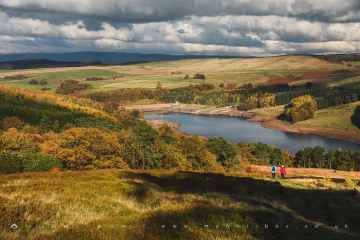Derby is a City in the county of Derbyshire.
Derby postcode: DE1 2AA
There are great places to visit near Derby including some great ancient sites, historic monuments, towns, caves, old mines, mountains, hiking areas, lakes, hills, ruins, rivers and streams, waterfalls, historic buildings, cities and shopping centres.
There are a number of ancient sites near Derby including Arbor Low Henge, Gib Hill Oval Barrow and Bowl Barrow, and Carl Wark Hillfort.
Arbor Low Henge is one of Derby's best, nearby historic monuments to visit in Derby.
Don't miss Castleton, Buxton, Darley Dale, and Hope's towns if visiting the area around Derby.
Blue John Cavern, Treak Cliff Cavern, and Odin Mine are great places to visit near Derby if you like caves.
Derby's best nearby old mines can be found at Blue John Cavern, Treak Cliff Cavern, and Odin Mine.
Places near Derby feature a number of interesting mountains including Kinder Scout.
Kinder Scout, Errwood Hall (ruin), Three Shires Head, and Hope Valley are some of Derby best hiking areas to visit near Derby.
There are a several good lakes in the area around Derby like Errwood Reservoir.
Derby's best nearby hills can be found at Shining Tor, and Higger Tor.
Derby's best nearby ruins can be found at Errwood Hall (ruin), and Castedge (ruin).
Derby's best nearby rivers and streams can be found at River Dane at Three Shires Head, and Panniers Pool.
Waterfalls to visit near Derby include Panniers Pool Waterfall, and Three Shires Head Waterfall.
Derby's best nearby historic buildings can be found at Solomon's Temple, and St Mary's Church Derby.
Derby is a great place to visit close to Derby if you like cities.
There are a several good shopping centres in the area around Derby like Derbion.
Derby History
There are some historic monuments around Derby:
Places to stay near Derby
Areas of Derby
Like most towns and cities Derby is comprised of a number of areas, once separate villages or small towns and parishes now part of Derby.
Many of the areas of Derby have their own character and places of interest.
Places to see near Derby
History of Derby
The town name does appear as ‘Darbye’ in early maps, such as that of John Speed, 1610. Modern research (2004) into the history and archaeology of Derby has provided evidence that the Vikings and Anglo-Saxons would have co-existed, occupying two areas of land surrounded by water. The Anglo-Saxon Chronicle (c. 900) says that “Derby is divided by water”. These areas of land were known as Nora¾wora¾ig (“Northworthy”, = “north enclosure”) and Deoraby, and were at the “Irongate” (north) side of Derby. During the Civil War of 1642-1646, Derby was garrisoned by Parliamentary troops commanded by Sir John Gell, 1st Baronet, who was appointed Governor of Derby in 1643. These troops took part in the defence of nearby Nottingham, the Siege of Lichfield, the Battle of Hopton Heath and many other engagements in Nottinghamshire, Staffordshire and Cheshire, as well as successfully defending Derbyshire against Royalist armies.






























